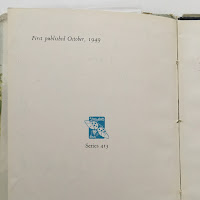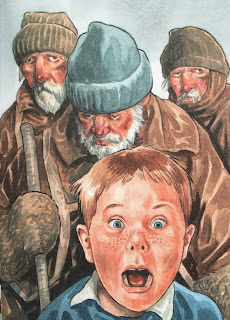It was in June last year (2016) that I received an email, telling me of the plans to issue a Ladybird Books set of stamps and asking if I would be consultant on the project.

Of course I said "Yes please".
A long-list had already been drawn up of the categories that were to be featured on the stamps. I was asked to suggest books that would fit those categories: favouring the most popular books but also representing titles from different periods. They were also keen that the most well-known artists should each be represented. Initially it hadn't been decided whether to feature only book covers or also inside pages. Eventually the decision was made to use cover pictures only - I think because the covers would have a greater resonance with a greater number of people. At this point I suggested that more use be made of the spines of the books - and not only because of their uniform size and vivid colours. Ladybird books are herd creatures - at their best when grouped together and it is sometimes the spines on the shelves of schools, libraries and shops that have made the deepest (if subconsious) impression on our memories.
As at every stage of this project, the painful bit was deciding what to leave out. The other challenge was keeping quiet about it all; I had been sworn to absolute secrecy from the very first email, and this was sometimes frustrating.
A couple of months later, when a shortlist of contenders had been decided upon, (after numerous emails back-and-forth) I was asked to provide the books to be photographed and invited to attend the photoshoot. So on the day in question I packed up smart copies of the selected books (and decided to add a few more, just-in-case) put them in a small case and followed the instructions to get to a photography studio in South London.
A man was there, setting everything up for the shoot. I've forgotten his name - I've forgotten the names of almost everyone I dealt with - but he was nice and friendly and might have been John and I'm sure there was a Dean. The design company was called 'True North'.

From my recent experience, it seems that a photography shoot requires a man (my experience suggests only men) to set up a lot of equipment, arrange things and light things, make coffee, walk round and peer on screens and down cameras, nudge things and then make more coffee. After about half an hour of this, another man will appear, introduce himself, make coffee, peer down cameras, give things a nudge, look at a screen or two, give things another nudge and then make more coffee. The same interval will elapse before the third man appears and repeats exactly the same procedure as with the second man. By the time there are four men, the photoshoot appears to be quorate - but the procedure remains the same. After all four men have peered and nudged and drunk enough coffee it is lunchtime.
I had a very enjoyable morning learning how a photoshoot is conducted. I also offered the occasional bit of advice (and was kindly told that my suggestions were 'invaluable') about the relative popularity of a book or an artist and what should be prominent - but for the most part I drank coffee.
Whether the procedure continued the same after lunch I can't honestly say (although I suspect it did) because I didn't think I could contribute any more and so I went home, leaving my books behind.
I was then sent proofs of what I thought would be the final stamps - and liked them very much. The 'casual' arrangement of books - achieved through an inordinate number of nudges - (see picture below) had been tidied up to feature 4 stamps in each picture which spilled out beyond the stamp borders. However, it turned out that there were still a number of other stages to be undergone and reviews by another couple of committees led to the decision to re-shoot in my absence. If anyone doesn't like the final stamps (and I much preferred the more imaginative earlier version) this is where I have an opportunity to abnegate responsibility for the choices made.
From each 'stamp' at least one book was dropped, which rather undid the painstaking balance of artists and eras but with the intention of achieving a much more simple, less cluttered look. Personally I preferred the cluttered look, but there you go. If you like the final stamps best, forget I said that.
A couple of months later, in February this year, my books came home to me, packed up in my suitcase and travelling by courier. I can confirm that no Ladybird books were harmed in the shooting of these stamps. But since then I've kept them in isolation from the rest of my books, thinking that I could auction off one or two of them for charity.
My next commission was to write the copy for the presentation packs that accompany the first-day covers and general background bumf. It had been decided to create a Ladybird ABC of snippets of information about the history, vintage books and artists. This immediately struck me as a very clever and appropriate idea and take my hat off to whoever suggested it. My first task with this stage of was enjoyable - to try to think of a suitable topic A-Z, giving a flavour of the vintage Ladybird story. If coming up with a category for each letter was a pleasure, trying to say what I wanted to say within a super-strict word-count was extremely frustrating. The attention to detail shown by the project editor was impressive. Clearly you would need to be exceedingly punctilious when you're dealing with experts and with stamp collectors and when publishing something with this sort of reach - but Helen (another one) was both meticulous and flexible.
A final piece of copy was required for the Royal Mail Yearbook - a publication I didn't previously know about. This book (published, as you might have guessed, annually) contains a chapter of further information about each topic featured on that year's stamp issue. After all the limitations and restrictions of the previous tasks, a bit of free-flowing prose - a chapter on the history of Ladybird Books - was again a pleasure to write.
But the best bit for me was probably the photoshoot for the Yearbook chapter. The initial 'place-holder' idea was to feature a large shot of a shelf of books perhaps in black and white - with some elements from the Ladybird story featured in colour. Because my collection is unusually extensive and because I have a good idea of what features of the Ladybird story are worth highlighting, I had offered to let the photographers take pictures of particular books or artifacts at my house. But when the designer saw a picture of my book-shed, they asked if they could photograph there.
By now I was experienced in Royal Mail photoshoots and was prepared for the men who arrived in stages, for the screens, the peering, the nudging and the need for regular refreshments; the Yearbook team, did not disappoint.
On arrival they all admired my book-shed and then decided to dismantle almost everything. Together we pulled most of the contents into the garden (it was a hot dry day and again no books were harmed in the creative process) gave it all a stir and then put it all back again in almost exactly the same position as it had been to start with. Then the photoshoot got underway, following the now-familiar process.


 Everyone involved was very nice and friendly and the fact that I've forgotten everyone's name (there was a Gary) is no reflection on them or my enjoyment of the whole day.
Everyone involved was very nice and friendly and the fact that I've forgotten everyone's name (there was a Gary) is no reflection on them or my enjoyment of the whole day.This time, however, there was a clear end to the photoshoot. They packed up the equipment and we went to the pub and then they went home.
After that, it was just a question of dealing with questions by email or phone. This went on over an extended period and even required me to do a bit of research when on holiday in China - quite a challenge on a mobile phone, with limited wi-fi and the Great Firewall of China preventing access to Google.
I know there is a small mistake in the graphics of the presentation pack that I picked up but that was never corrected. I say no more.
The stamps came out on Thursday 14th September 2017. The yearbook (with the shed-shoot) won't be out for a little while yet.
Every dog has its day - but the 14th of September was not one of unalloyed joy.
Disappointingly, the press release - disseminated widely online and in the national papers - made extensive use of my copy but no use at all of my name. I received no acknowledgement for the loan of my resources or involvement beyond the 'words'.
It turns out that this was an oversight. Now forgive me for this, but I would like to put it in writing, if only on my own blog, these words from an email I have just received from a manager at the Royal Mail, regretting that the stamps and ephemera do not include "a reference to your invaluable contribution to the stamp designs." The message ends "All I can do is to offer my apologies."
Pazienza. It was a pleaure and a privilege to be involved.
And now you know How-it-Works, I hope you'll go out and buy some of this lovely collection:
http://shop.royalmail.com/icat/ladybird-books/icat/ladybirdbooks

































